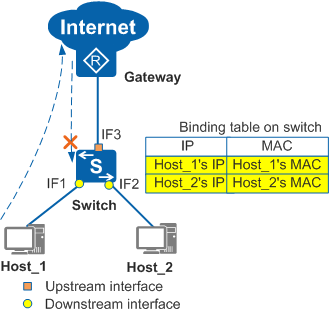Services Are Interrupted After IPSG Is Enabled on the Upstream Interface
Fault Description
After IPSG is enabled on an interface, all hosts on the interface cannot access the Internet. Services on the hosts are abnormal.
Procedure
- Check whether IPSG has been enabled on an upstream interface.
Generally, IPSG is enabled on the user-side (downstream) interface. If IPSG is also enabled on the upstream interface, the return packets may be discarded. As a result, user services are interrupted.
In Figure 1, after static binding entries are configured on the switch for Host_1 and Host_2, and IPSG is enabled on IF1, IF2, and IF3, the hosts cannot access the Internet. However, the hosts can communicate with each other. Host_1 is used as an example here to describe the fault symptom:- Host_1 sends a packet to the Internet. When the packet reaches IF1 of the switch, the switch detects that the packet matches a binding entry, and forwards it.
- A packet is sent from the Internet to Host_1. When the packet reaches IF3, the switch detects that the packet does not match any binding entry, and discards the packet.
- Perform the following operations:
- Run the display ip source check user-bind interface interface-type interface-number command to check whether IPSG is enabled on the upstream interface IF3.
- If "ipv4 source check user-bind enable" or "ipv6 source check user-bind enable" is displayed, IPSG has been enabled on the upstream interface. Run the undo ip source check user-bind enable command in the interface view to disable IPSG on the upstream interface IF3.
